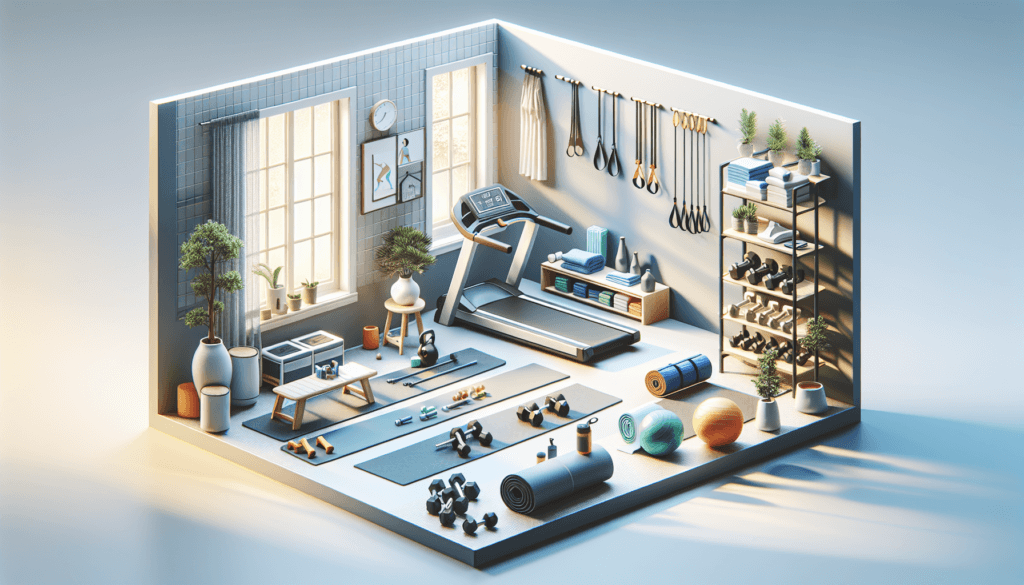So, you’ve decided to take the leap and start your very own home gym! Congratulations on making this exciting decision to bring the gym experience right to your doorstep. Whether you’re a fitness enthusiast looking to save time and money or simply want the convenience of exercising at home, this article has got you covered. In just 10 easy steps, we will guide you through the process of setting up your perfect workout space, from choosing the right equipment to creating a motivating environment that will keep you on track to achieve your fitness goals. So let’s get started on this exciting journey towards a healthier and fitter you!
Choosing the Right Location

Selecting a suitable space
When starting your own home gym, one of the first things you need to consider is the location. You want to choose a suitable space that fits your needs and allows you to comfortably exercise. Look around your home and identify an area that can be dedicated to your workout routines. It could be a spare bedroom, a basement, or even a corner of your living room. Think about the size of the space and whether it can accommodate the equipment you plan to have. Additionally, consider the accessibility of the location and whether it provides the privacy you desire for your workout sessions.
Considering noise and ventilation
Another crucial factor to consider when selecting the location for your home gym is noise and ventilation. Depending on the type of exercises you’ll be doing, your gym may produce some noise. If you live in a shared space or have neighbors nearby, it’s important to choose a location where the noise won’t disturb others. Consider using soundproofing materials or opting for a location far away from common living areas. Additionally, proper ventilation is essential to keep your home gym comfortable and free from unpleasant odors. Make sure the space has good airflow and consider investing in fans or even opening windows during your workouts.
Assessing Your Fitness Needs
Determining your goals
Before diving into setting up your home gym, it’s important to evaluate your fitness goals. What do you hope to achieve through your workouts? Are you aiming to build muscle, lose weight, increase endurance, or improve flexibility? Understanding your goals will help you determine the type of exercises and equipment you will require. It will also guide you in selecting appropriate weights, cardio equipment, or specialized gear to support your fitness journey.
Identifying the equipment you need
Once you have established your fitness goals, the next step is to identify the specific equipment you need to achieve them. This will largely depend on the type of exercise you plan to incorporate into your routine. For example, if you’re focused on strength training, you will need dumbbells, barbells, and weight plates. On the other hand, if you prefer cardiovascular exercises, you may want to look into treadmills, stationary bikes, or rowing machines. Make a list of the equipment that aligns with your goals, and take into account the available space in your home gym.
Setting a Budget
Researching equipment costs
Setting up a home gym can be an investment, but it doesn’t have to break the bank. Before making any purchases, take the time to research equipment costs. Compare prices from different retailers and look for sales or discounts. You may also consider buying used equipment, which can often be found at a lower cost. By doing thorough research, you can get a sense of how much you need to budget for your home gym.

Accounting for additional expenses
When setting a budget for your home gym, it’s important to account for additional expenses beyond the cost of equipment. This can include things like flooring, mirrors, storage racks, and lighting fixtures. You may also need to factor in installation or delivery fees, as well as ongoing maintenance costs. By considering all these potential expenses, you can ensure that your budget is realistic and comprehensive.
Designing Your Gym Layout
Measuring the available space
Once you have chosen the location for your home gym, it’s time to measure the available space. Grab a measuring tape and accurately measure the dimensions of the area. This information will be crucial when determining how much equipment you can fit and how to arrange it efficiently.
Arranging equipment strategically
To create an efficient and functional home gym, it’s important to arrange your equipment strategically. Start by placing larger pieces of equipment, such as treadmills or weight benches, in the center of the room. This will allow for adequate space around them and make it easier to navigate. Consider grouping similar types of equipment together and leaving enough room for movement and stretching. Additionally, ensure that there is enough clearance between different pieces of equipment to prevent accidents and allow for a comfortable workout experience.
Choosing the Right Equipment
Considering your fitness goals
When selecting equipment for your home gym, it’s crucial to consider your fitness goals. Different types of equipment will target specific muscle groups or help you achieve specific objectives. For example, if you’re aiming to improve overall cardiovascular health, opt for equipment like treadmills or elliptical machines. On the other hand, if building strength is your focus, invest in dumbbells, barbells, or resistance bands. Understanding your goals will help you make informed decisions about the equipment that will best support your fitness journey.
Researching different types of equipment
To ensure you select the right equipment for your home gym, take the time to research different options. Read reviews, watch videos, and consult with fitness professionals to gain a better understanding of the benefits and drawbacks of various equipment types. Consider factors such as durability, ease of use, and versatility. Don’t hesitate to reach out to individuals who have experience with home gyms, as their insights can be invaluable.

Opting for multipurpose equipment
If space is limited in your home gym, a great solution is to invest in multipurpose equipment. These are pieces of equipment that offer various exercises or functions within a single unit. For example, a cable crossover machine allows you to perform a wide range of exercises for different muscle groups. By opting for multipurpose equipment, you can maximize the versatility of your home gym without sacrificing valuable space.
Investing in Essential Equipment
Prioritizing safety and comfort
When building your home gym, it’s vital to prioritize safety and comfort. Begin by investing in equipment that has appropriate safety features and is built to withstand regular use. Look for well-constructed machines with stable frames and secure weight stacks. Comfort is equally important, especially when it comes to cardio equipment or items you will be using for extended periods. Test equipment out before purchasing to ensure it feels comfortable and suits your body’s needs.
Starting with fundamental equipment
If you’re just starting with your home gym, it’s wise to begin with fundamental equipment. These are the essentials that will provide a solid foundation for your workouts. Examples include dumbbells, resistance bands, an exercise mat, and a stability ball. By starting with these basics, you can gradually add more equipment as you become familiar with your fitness routine and identify additional needs.
Expanding gradually
As you progress in your fitness journey and gain a better understanding of your needs, you can start expanding your equipment collection gradually. Listen to your body and identify areas where you might benefit from additional equipment. For instance, if you find that you enjoy strength training more than cardio, you can invest in a power rack or a set of kettlebells. By expanding your equipment collection over time, you can create a diverse and motivating workout space.
Considering Space-Saving Options
Folding equipment
If you have limited space in your home gym, consider investing in folding equipment. Many manufacturers offer folding options for treadmills, weight benches, and even cardio machines. These pieces of equipment can easily be folded and stored away when not in use, allowing you to maximize the available space in your home gym.

Wall-mounted equipment
Another excellent solution for saving space in your home gym is to opt for wall-mounted equipment. This includes items like chin-up bars, suspension trainers, and wall-mounted racks or shelving. By utilizing the vertical space on your walls, you can free up valuable floor space while still having access to essential equipment.
Modular storage solutions
To keep your home gym organized and efficient, consider investing in modular storage solutions. These are customizable shelving or storage cabinets that allow you to store your equipment in a neat and organized manner. Look for options that can accommodate your specific equipment needs and easily adapt as your collection grows. By keeping your equipment properly stored, you can ensure a clutter-free and functional workout space.
Ensuring Proper Ventilation and Lighting
Installing proper ventilation systems
Proper ventilation is essential in any home gym to maintain a comfortable and healthy environment. Consider installing ventilation systems such as fans or vents to ensure adequate airflow. Good ventilation helps prevent the buildup of odors, moisture, and stale air, making your workouts more enjoyable. Depending on your space, you may also want to consider opening windows or investing in a dehumidifier to control humidity levels.
Choosing appropriate lighting
Having adequate lighting in your home gym is essential for both safety and motivation. Look for lighting fixtures that provide bright, natural light and distribute it evenly throughout the space. Avoid harsh or dim lighting, as it can lead to fatigue or strain on your eyes. Additionally, consider adding adjustable lighting options, such as dimmers or spotlights, to create the ideal atmosphere for different types of workouts.
Creating a Comfortable Atmosphere
Adding mirrors
Mirrors are not only functional but also aesthetically pleasing additions to any home gym. They allow you to check your form and technique during workouts, reducing the risk of injury. Additionally, mirrors create an illusion of space, making your gym feel larger and more open. Consider placing mirrors strategically to capture different angles and maximize their impact.
Using appropriate flooring
Choosing the right flooring for your home gym is crucial for safety and comfort. Opt for durable and non-slip flooring materials that can withstand heavy equipment and provide protection for your joints. Options such as rubber flooring or foam interlocking tiles are popular choices due to their shock-absorbing properties. Additionally, make sure the flooring is easy to clean and maintain, as it will endure the wear and tear of regular workouts.
Setting up a sound system
To enhance your workout experience, consider setting up a sound system in your home gym. Music can be a great motivator and help you stay focused during your workouts. Invest in a quality speaker system that suits the size of your space and consider opting for wireless options for convenience. Additionally, if you enjoy following workout routines or instructional videos, make sure your sound system allows for clear and crisp audio.
Maintaining and Cleaning Your Home Gym
Establishing a regular cleaning routine
To keep your home gym clean and hygienic, establish a regular cleaning routine. Create a checklist of tasks, such as wiping down equipment, sanitizing surfaces, and vacuuming or sweeping the floor. Regular cleaning helps prevent the buildup of dirt, sweat, and germs, ensuring a safe and pleasant workout environment.
Checking equipment for maintenance needs
Regular maintenance is vital to ensure your equipment remains safe and in good working condition. Periodically check your equipment for any signs of wear and tear, loose screws, or malfunctioning parts. Follow the manufacturer’s instructions for maintenance and make any necessary adjustments or repairs promptly. By addressing maintenance needs in a timely manner, you can prolong the lifespan of your equipment and prevent accidents or injuries.
Replacing worn-out or damaged equipment
Over time, equipment may become worn out or damaged, and it’s important to replace them to maintain a safe and effective home gym. Inspect your equipment regularly and look for signs of deterioration, such as frayed cables, cracked handles, or unstable frames. If you notice any issues, consider replacing the equipment to ensure your workouts remain safe and enjoyable. Remember to dispose of old equipment responsibly, adhering to local disposal guidelines.
Starting your own home gym is an exciting endeavor that allows you to prioritize your health and fitness goals conveniently from the comfort of your home. By carefully considering the location, your fitness needs, and budget, you can create a personalized workout space that suits your unique preferences. Remember to choose equipment that aligns with your goals, takes into account space limitations, and allows for efficient organization. With proper ventilation, adequate lighting, and comfortable features, you can create an inviting atmosphere that motivates you to exercise regularly. Finally, by maintaining and cleaning your home gym regularly, you can ensure that it remains a safe and enjoyable space for years to come. So, take the first step, design your home gym, and embark on a rewarding fitness journey!


